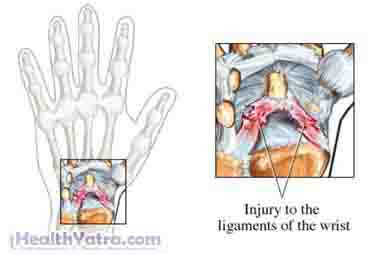Wrist Sprain Treatment in India
A wrist sprain is stretching or tearing of the ligaments that support the wrist. Ligaments are strong bands of tissue that connect bones to each other. Repetitive motion can also lead to these types of injuries.

Causes
The most common cause of a wrist sprain is falling on an outstretched hand.
Risk Factors
Factors that increase your chance of getting a wrist sprain include:
- Playing sports
- Poor coordination
- Poor balance
- Reduced flexibility and strength in muscles and ligaments
- Loose joints
- Not wearing wrist guards during activities such as in-line skating
Symptoms
If you have any of these symptoms, do not assume it is due to a wrist sprain. These symptoms may be caused by other conditions:
- Pain, tenderness, and swelling around the wrist
- Redness, warmth, or bruising around the wrist
- Limited ability to move the wrist
It can be hard to tell the difference between a wrist sprain and a fracture or dislocation of one of the small wrist bones. See your doctor if there is any deformity, swelling, or if you are unable to move your wrist or hand.
Diagnosis
Your doctor will ask about your symptoms and how you injured your wrist. An exam of your wrist will be done to check the stability of the joint and the severity of the injury.
- Images may need to be taken of the affected area. This can be done with:
- X-ray
- MRI scan
- CT scan
- Arthroscopy
- Bone scan
Wrist sprains are graded according to their severity:
Grade 1
- Stretching and small tearing of ligament tissue
Grade 2
- Partial tearing of ligament tissue
- Mild instability of the joint
- May affect function of the hand and wrist
Grade 3
- Severe or complete tearing of ligament tissue
- Significant instability of the joint
- Can be associated with fractures
Treatment
Treatment includes:
RICE
- Rest—Do not use your injured wrist and hand.
- Ice—Apply ice or a cold pack to the wrist for 15-20 minutes. Do this four times a day for several days. This helps reduce pain and swelling. Wrap the ice or cold pack in a towel. Do not apply the ice directly to your skin.
- Compression—Wrap your wrist in an elastic compression bandage. This will limit swelling and support your wrist.
- Elevation—Keep the injured wrist raised above your heart for 48 hours. You can use a pillow to do this. It will help drain fluid and reduce swelling.
Medication
The following medicines may help reduce inflammation and pain:
- Ibuprofen (Motrin, Advil)
- Naproxen (Aleve, Naprosyn)
- Acetaminophen (Tylenol)
- Aspirin
Topical pain medicines like creams and patches are also available. They are applied to the skin.
Other
- Brace—You may need to wear a brace to keep your wrist still as it heals. If you play sports, you may need to wear a wrist brace, or tape your wrist when you return to your sport.
- Cast—If you have a severe sprain, your doctor may recommend a cast for 2-3 weeks.
- Rehabilitation exercises—Begin exercises to restore flexibility, range of motion, and strength in your wrist as recommended by your doctor.
- Surgery—Surgery is rarely needed to repair a wrist sprain. However, surgery may be needed to repair a ligament that is torn completely, or if there is an associatedfracture.
Prevention
Wrist sprains usually occur from accidents that cannot be prevented. However, wearing protective wrist guards when in-line skating will help prevent wrist sprains caused by falling while skating.
